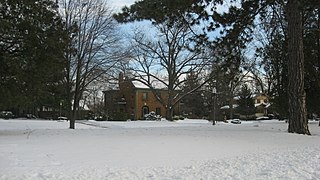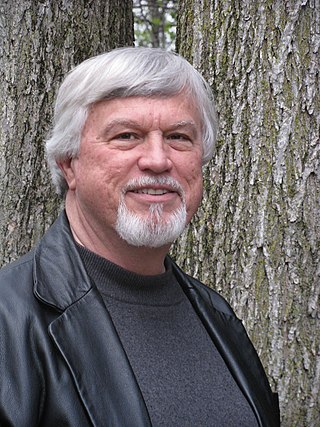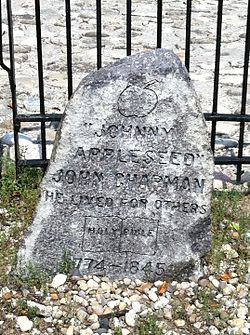
Fort Wayne is a city in and the county seat of Allen County, Indiana, United States. Located in northeastern Indiana, the city is 18 miles (29 km) west of the Ohio border and 50 miles (80 km) south of the Michigan border. The city's population was 263,886 as of the 2020 Census, making it the second-most populous city in Indiana after Indianapolis, and the 76th-most populous city in the United States. It is the principal city of the Fort Wayne metropolitan area, consisting of Allen and Whitley counties which had an estimated population of 423,038 as of 2021. Fort Wayne is the cultural and economic center of northeastern Indiana. In addition to the two core counties, the combined statistical area (CSA) includes Adams, DeKalb, Huntington, Noble, Steuben, and Wells counties, with an estimated population of 649,105 in 2021.

Johnny Appleseed was an American pioneer nurseryman, who introduced apple trees to large parts of Pennsylvania, Ohio, Indiana, Illinois, and present-day Ontario, as well as the northern counties of present-day West Virginia. He became an American legend while still alive, due to his kind, generous ways, his leadership in conservation, and the symbolic importance he attributed to apples. He was also a missionary for The New Church (Swedenborgian) and the inspiration for many museums and historical sites such as the Johnny Appleseed Museum in Urbana, Ohio.

The Fort Wayne TinCaps are a Minor League Baseball team of the Midwest League and the High-A affiliate of the San Diego Padres. They are located in Fort Wayne, Indiana, and play their home games at Parkview Field. They won their lone Midwest League championship in 2009.

The Fort Wayne Old City Hall Building in downtown Fort Wayne, Indiana operates as a museum known as The History Center, and has served as headquarters for the Allen County–Fort Wayne Historical Society since 1980. The Richardsonian Romanesque style sandstone building was designed by the architectural firm Wing & Mahurin and built in 1893. It served as a functioning city hall for the city until 1971 when local officials moved to the City-County Building.

Fort Frederica National Monument, on St. Simons Island, Georgia, preserves the archaeological remnants of a fort and town built by James Oglethorpe between 1736 and 1748 to protect the southern boundary of the British colony of Georgia from Spanish raids. About 630 British troops were stationed at the fort.

Allen County War Memorial Coliseum is a 13,000-seat multi-purpose arena located in Fort Wayne, Indiana, near present-day Johnny Appleseed Park. It opened in 1952 with a construction cost of nearly $3 million. The Allen County War Memorial Coliseum was originally designed to seat 8,103 for hockey or 10,240 for basketball. Opened in 1989, the Coliseum's $26 million Exposition Center contains 108,000-ft² (0.100-km2) devoted to hosting substantial trade shows and other events with seating for 7,500.
Memorial Stadium was a stadium located in Johnny Appleseed Park in Fort Wayne, Indiana. It was primarily used for baseball, and was the home field of the Fort Wayne Wizards of the Midwest League baseball team. Memorial Stadium was dedicated on April 18, 1993 before a sold-out crowd.
Allen Hamilton (1798–1864) was a founding father of Fort Wayne in Allen County, Indiana.

The Williams–Woodland Park Local Historic District was established in 1985 and is a national historic district located at Fort Wayne, Indiana. The district encompasses 287 contributing buildings in a predominantly residential section of Fort Wayne located approximately one mile south of downtown. The area was developed from about 1875 to 1940, and includes notable examples of Colonial Revival, Prairie School, and Queen Anne style residential architecture.

The Forest Park Boulevard Historic District is a national historic district located at Fort Wayne, Indiana. The district encompasses 93 contributing buildings, 1 contributing site, and 15 contributing objects in a predominantly residential section of Fort Wayne. The area was developed from about 1890 to 1955, and includes notable examples of Colonial Revival and Tudor Revival style architecture. The district features ornamental light posts / streetlights and stone entry markers.

Smith Field is a public airport north of downtown Fort Wayne, in Allen County, Indiana. It is owned and operated by the Fort Wayne Allen County Airport Authority. In the FAA's National Plan of Integrated Airport Systems for 2009–2013 it is a general aviation airport. The airport was listed on the National Register of Historic Places in 2002.

The Rivergreenway is the backbone of burgeoning Fort Wayne Trails network in Fort Wayne, Indiana and the surrounding area. The Rivergreenway consists of nearly 25-miles of connected trails through a linear park following alongside or near the City's three rivers: St. Joseph River, St. Marys River, and Maumee River. In 2009, the Rivergreenway was designated as a National Recreation Trail. The trail network also connects to the Wabash & Erie Canal Towpath Trail. In 2011, the Wabash & Erie Canal Towpath Trail was completed, the Greater Fort Wayne has 50 miles of connected trails.

Gary Tillery is an American writer and artist known for his biographies focusing on the spiritual lives of famous figures, and for his public sculptures. His 2009 book, The Cynical Idealist, was named the official book of the 2010 John Lennon Tribute in New York City, and he created the centerpiece sculpture of the Chicago Vietnam Veterans Memorial, dedicated in 2005.

Lindenwood Cemetery is a rural cemetery operated by Dignity Memorial in Fort Wayne, Indiana, established in 1859. With over 74,000 graves and covering 175 acres (0.71 km2), it is one of the largest cemeteries in Indiana.

The McColloch-Weatherhogg Double House, also known as the J. Ross McCulloch House, is a historic residential building constructed in 1883 in the Victorian Gothic Revival style at 334-336 E. Berry St., Fort Wayne, Indiana. The building is now the home of United Way of Allen County and was listed on the National Register of Historic Places on December 7, 2001.

Thomas W. Swinney House, also known as The Swinney Homestead, is a historic home located at Fort Wayne, Indiana. It was built in 1844-1845 as a 1+1⁄2-story brick and limestone structure. It was enlarged with a 2+1⁄2-story, square, Late Victorian style brick wing about 1885. It features an Eastlake movement front porch. It was built by Thomas J. Swinney, a pioneer settler of Allen County and prominent Fort Wayne businessman. The house and land for Swinney Park were passed to the city of Fort Wayne in 1922.

North Anthony Boulevard Historic District is a national historic district located at Fort Wayne, Indiana. The district encompasses 296 contributing buildings in a predominantly residential section of Fort Wayne, extending along North Anthony Boulevard from Lake Avenue in the south to Vance Avenue in the north. An overlapping designation includes all of the rights of way in the district, plus those on the rest of North Anthony south to the Maumee River, as well as on South Anthony Boulevard south of the river.

Fort Wayne Park and Boulevard System Historic District is a national historic district located at Fort Wayne, Indiana. The district encompasses 34 contributing buildings, 61 contributing sites, 70 contributing structures, and 15 contributing objects in 11 public parks, four parkways, and ten boulevards associated with the parkway and boulevard system in Fort Wayne. The system was originally conceived in 1909 by Charles Mulford Robinson (1869–1917) and further developed and refined by noted landscape architect and planner George Kessler (1862-1923) in 1911–1912. The buildings reflect Classical Revival and Bungalow / American Craftsman style architecture. Later additions and modifications include those by noted landscape architect Arthur Asahel Shurcliff.
Hursh Road Bridge was a historic Whipple truss bridge spanning Cedar Creek near Cedarville, Allen County, Indiana. It was built in 1879 by the Western Bridge Works of Fort Wayne, Indiana. It was a 120 foot long, 16 feet wide ornate iron bridge.

LaGrange County Courthouse is a historic courthouse located on Detroit Street in LaGrange, LaGrange County, Indiana. It was designed by Thomas J. Tolan, & Son, Architects of Fort Wayne, Indiana and built in 1878–1879. It is a two-story, rectangular red brick building with Second Empire and Georgian style design elements. The front facade consists of a central clock tower flanked by square corner pavilions.






















